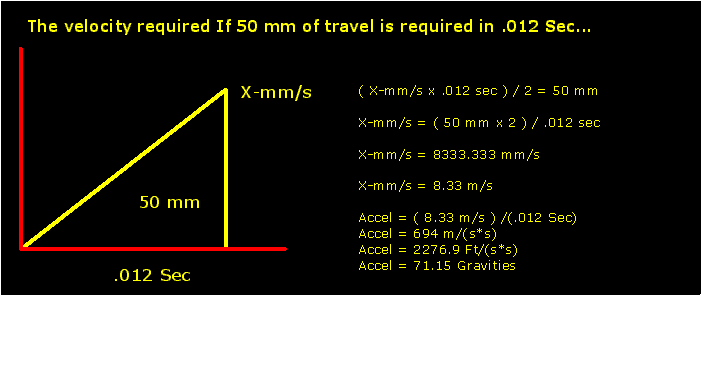Which is more important?
Attaining a velocity of 3 meters/sec in .012 sec?
Attaining a velocity of 3 meters/sec in 50 mm?
or Moving 50 mm in .012 sec?
THEORETICALLY, you can have one and only one of those conditions!
YOU CAN NOT HAVE ALL OF THEM!
Having all three of these conditions is a physical impossibility - it's against the Laws of Physics!
"1 motion 1"
"1 motion 2"
"1 motion 3"
All of the preceding is dealing with the problem as if all theoretical conditions are perfect!
Essentially, the mass of the mover and the moved item needs to be insignificant - if so, then the inherent inertia problem becomes moot.
Then, it is also required that the moved object be in contact with the mover before the mover begins moving.
When the mover and the moved object is at the target speed, then the mover must either reduce speed immediately or maintain speed without continuing acceleration.
Basically, I see the problem as being insurmountable!! At least, with the curretly described method. There are way too many variables in the game!
My best shot at this would be to use the "Flying Cross-Cut Saw Method".
At a certain trip-point, the saw begins to track the "flying" piece of wood. At some point the speeds and position are seen to be in-sync. The saw then begins to do the cross-cut.
Coming into sync is one problem, doing the cross-cut is another.
Executing the cross-cut is nothing more than a simple trigonometry problem- speed-this-way vs. speed-that-way
Coming up to speed at the point where the cut can begin is a little tougher. The start-point has to be attained before a certain point.
It takes a certain amount of time to make the cross-cut. If the saw can't get into position before the drop-dead-point then a cut is not made.
The point being, if you know how long a cross-cut takes, and you know the physical length of the cross-cut framework, then you how much time you have to get into sync.
Different situations require the drop-dead-occurrance to be handled in different ways.
Now, back to the current issue...
Use a Servo to match speed and then drop the part, damned near exactly where it needs to be!
Use a servo to pick-up a part and then use that servo to match speed with the belt in such a manner that when the part is dropped it could easily be seen that the speed difference between the servo and the belt is zero (or damned near!).
It would be as if a pick-n-place grabber was simply picking up a part and then dropping it somewhere on a non-moving location.
The method I suggest is to try to hit a moving target from a moving and controllable platform. The target is moving at a fixed speed and the control of the "shooter" is variable by design!
This is quite different from a situation where the target is moving and the "shooter" is variable but not controllable!
I do have to say, however, this exercise has given me an idea for an accelerator device that should give reasonably consistant and reliable accelerations to items as suggested. Of course, I will stay within the Laws of Physics!









